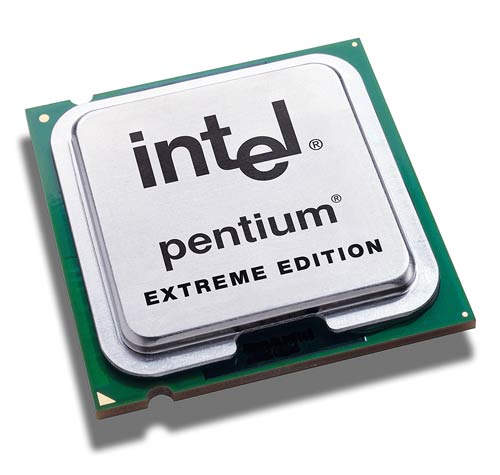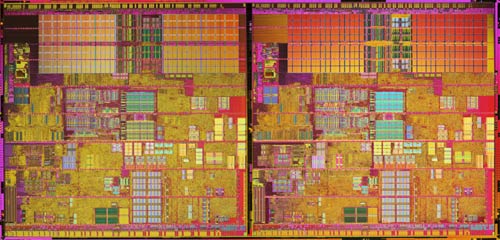Intel Dual Core Performance Preview Part I: First Encounter
by Anand Lal Shimpi on April 4, 2005 2:44 PM EST- Posted in
- CPUs
The Chip: Pentium Extreme Edition
As we mentioned in our IDF coverage, Intel has dropped the number 4 from their naming for their dual core parts. The new dual core desktop CPUs will simply be called the Pentium D and the Pentium Extreme Edition.

Both the Pentium D and Pentium Extreme Edition are nothing more than two 90nm Prescott 1M dies glued together. That means that each core has its own 1MB L2 cache, and that also means that architecturally, these chips are no different than the single core Pentium 4s that are out today - other than the obvious dual core fact.

Contrary to what we've reported earlier, the only difference between the Pentium D and the Pentium Extreme Edition is the presence of Hyper Threading; mainly, the Pentium D doesn't have it, while the Extreme Edition does. Both chips will only use a 800MHz FSB, they both have the same cache sizes, and they only differ in the presence of HT.
Armed with Hyper Threading, the Pentium Extreme Edition allows the execution of 4 concurrent threads and appears as a quad processor CPU to the OS. Without Hyper Threading, the Pentium D only allows for 2 concurrent threads and appears as a dual processor CPU to the OS.
While the Pentium D will be offered in three speed grades, from 2.8GHz up to 3.2GHz, the Extreme Edition will only be launched at 3.2GHz. Note that the fastest single core Pentium 4s run between 3.6GHz and 3.8GHz, so there is a significant clock speed penalty paid by going to dual core.










141 Comments
View All Comments
mlittl3 - Tuesday, April 5, 2005 - link
#90,Please, oh, please read Anand's blog from now on. He did just as you are suggesting a couple of days ago before the article was posted/written. He asked the readership for multitasking scenarios and he but those in the article.
Read his blogs. They are awesome.
Keep up the good work, Anand and Anandtech staff, and even though you don't have to give into the naysayers about lack of gaming benchmarks, thanks for being understanding and giving the readers what they want.
That is the sign of true journalistic integrity. :)
suryad - Tuesday, April 5, 2005 - link
As always great work Anand, and for all the users griping about the multitasking testing setup, well maybe Anand would be open to a set of multitasking suggestions his readers most regularly do. Maybe we can all offer suggestions and they will be tested for the second look probably sometime in the future on dual cores and hopefully AMD will have their bad boys out off the cage by then.Also benches on Linux would be great...64 bit and 32 bit.
Surya
Anand Lal Shimpi - Tuesday, April 5, 2005 - link
kjohnsonI'll let my actions speak for themselves, I've got gaming in Part II and surprisingly enough, it's no different than what I said in Part I - gaming performance of the dual core Pentium D is identical to a single core Pentium 4 of the same clock speed.
The multitasking tests in Part I were largely determined by responses to a "how do you multitask" question I posted in my blog on Friday. Out of the 65 responses, hardly any mentioned gaming as a multitasking scenario, so given my limited time with the system I decided to focus on what the readers asked for. That's also why I split the article into multiple parts, I knew that more performance testing would be desired but a desire for information would also be there on day one.
Insinuating that Intel somehow strong armed me into excluding certain benchmarks is just ignorant of how things work, at least at AnandTech. It's a great way to get attention but it's way off base. Intel told me when the system was shipping and when the NDA lifted, no more, no less. I spent all weekend putting together benchmarks that I thought the readership would like to see, not simply re-run benchmarks that we already had results of.
I've been doing this for 8 years, and the one thing I've always known is that it doesn't matter who is first to publish an article, but it is the article that does the best job and is the most thorough that matters. Trading integrity for exclusivity never makes sense, thinking it does requires a very short term memory and no sense of how things pan out in the long run. Being that in 3 weeks AnandTech will celebrate its 8th year anniversary, I don't think you can argue that type of thinking is characteristic of myself or anyone at this site.
But I'm not here to try and correct anyone's misconceptions of myself or this site, I'm here to deliver what the readers want and what will help you all make the best, most accurate purchasing decisions. In doing so I've taken every last comment to heart, as I always do, and I'm doing my best to incorporate your requests into Part II...just as I did in Part I.
As I mentioned in my blog, I'm an open book with nothing to hide, if there are questions of integrity or ethics fire away and I'll be more than happy to answer them.
Take care,
Anand
Amagus - Tuesday, April 5, 2005 - link
Wow that Inquirer article basically insinuates that Anand (it's obvious who he's referring to) was bought out because part I of a preview (!!) didn't contain any gaming benchmarks. I wouldn't stand for that.blwest - Tuesday, April 5, 2005 - link
Nice article, as always. I wonder how memory bandwidth increases/decreases will effect the performance of the already bandwidth hungry intel processors.michael2k - Tuesday, April 5, 2005 - link
#83, #85Gaming wasn't addressed because gaming, by itself, won't see huge improvements with dual core*
If you run IRC, AIM, FireFox, and BitTorrent while you game, then yes, you will see a performance increase, but not over a single core CPU running only the game by itself. A fast single core CPU will be much, much, better for a game. Or if you run WoW and EQ on two monitors, you will see a benefit.
*Drastic rewrites of OpenGL and DirectX will see benefits with dual core. For example, if front and back buffers were handled by different CPUs, or if you can split the screen into to sections and have one half processed by one CPU and the other half by another. Another performance technique might be to let one CPU deal with vertex culling, occlusion, and decomposition, while the other CPU deals with shadow calculations, or something suitably complex. But that requires the game to be written for dual core, and won't appear on games already on the market.
kjohnson - Tuesday, April 5, 2005 - link
Here's why this article does not mention any gaming benchmarks:http://www.theinquirer.net/?article=22332.bdchambers79 - Tuesday, April 5, 2005 - link
I just thought I'd say, I often run the Persistance of Vision Raytracer (www.povray.org) in the background on my computer for several hours (or days... hehe) at a time. While it's running, I am able to do little more than edit text. However, I also like to code and play games.So, what I would like to see would be POV-Ray running in the background, with MS Dev Studio or GCC running multiple times in the foreground; or, POV-Ray in the background with a game (NOT necessarily Doom3, guys, though it would be a good benchmark) in the foreground (perhaps in a window, so you can see POV's results). Or, for those truly masochistic souls, POV, DevStudio and Doom3 all running at the same time (though that's less likely to occur in RL) :)
BLHealthy4life - Tuesday, April 5, 2005 - link
I didn't read every single post here, but i do hope that it's ben mentioned that there were wasn't one single game run on this system. Surely this will be done in part two??fitten - Tuesday, April 5, 2005 - link
#80, that kind of change won't happen withough redigning the memory interface (of either) which would mean that current motherboards wouldn't be able to use the parts (which at least AMD is claiming will be possible).